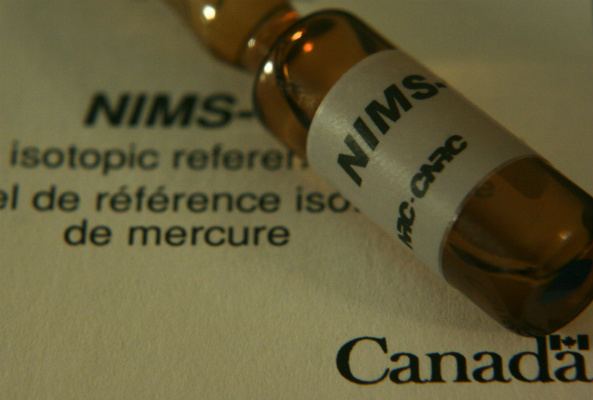Canadian Reference Materials (CRM) are certified reference materials of high-quality and reliability produced by the National Metrology Institute of Canada – the National Research Council Canada. The NRC Certified Reference Materials program is operated by the Measurement Science and Standards portfolio and provides CRMs for environmental, biotoxin, food, nutritional supplement, and stable isotope analysis. The program was established in 1976 to produce CRMs for inorganic and organic marine environmental analysis and remains internationally recognized producer of CRMs.
NRC produces certified reference materials of biological tissues, isotopic standards, natural waters, sediments, supplements, and natural health products. With the exception of the ORMS, the river water CRM with elevated mercury, all materials contain natural levels of analytes in their native matrix.
Biological tissuesDOLT, dogfish liver for trace metalsDORM, fish protein for trace metalsLUTS, non-defatted lobster hepatopancreas for trace metalsTORT, lobster hepatopancreas for trace metalsIsotopic materialsNIMS, natural inorganic mercury standardEMMS, isotopic methylmercury standardNatural watersCASS, near-shore seawater for trace metalsMOOS, seawater for nutrientsNASS, seawater for trace metalsORMS, river water for mercurySLEW, estuarine water for trace metalsSLRS, river water for trace metalsSedimentsHISS and MESS, marine sediment for trace metals and major constituentsPACS and SOPH, marine sediment for trace metals and major constituentsSupplements and natural health productsCACB, calcium carbonate for lead and cadmiumFEBS, otolith for trace metalsSELM, selenium-enriched yeast for seleniumIn 1977, Edmonds et al. reported the identification, isolation, and synthesis of major arsenic-containing substance in sea organisms, the arsenobetaine. In 1999, NRC certified arsenobetaine in the dogfish muscle material DORM-2, which became the first matrix reference material certified for arsenobetaine. Before DORM-2, DORM-1 (issued in 1986) served as the reference material for which the concentration of arsenobetaine was widely reported in scientific literature. Besides arsenobetaine, NRC currently offers matrix reference materials certified for methylmercury (TORT-3), dibutyltin, and tributyltin (PACS-3).
Biological tissues and sedimentsCARP, fish for dioxins, furans, and PCBsDOLT, dogfish liver for methylmercuryDORM, fish protein for methylmercuryTORT, lobster hepatopancreas for methylmercury and arsenobetainePACS and SOPH, marine sediment for dibutyltin and tributyltinSELM, selenium-enriched yeast for methionine and selenomethionineIn 1987 Canada witnessed a crisis in the seafood industry. Shellfish toxins present in PEI mussels caused amnesic shellfish poisoning taking several lives. In response, shellfish toxin research was initiated at NRC Canada. Today, NRC remains the premier producer of biotoxin CRMs in the world and is recognized for its expertise.
Amnesic shellfish poisoning toxinsASP-Mus-d, mussel tissue for domoic acid and its isomersDA-f, domoic acid standardDiarrhetic shellfish poisoning and other lipophilic toxinsAZA, azaspiracid standardsDSP-Mus, mussel tissue for okadaic acidOA, okadaic acid standardDTX, dinophysistoxin standardsGYM, gymnodimine standardsYTX and hYTX, yessotoxin standardsPTX, pectenotoxin-2 standardSPX, 13-desmethyl spirolide C standardMicrocystinsdmMCLR and MCLR, microcystin-LR standardsMCRR, microcystin-RR standardNODR, nodularin-R standardParalytic shellfish poisoning toxinsC1&2, N-sulfocarbamoyl-gonyautoxin standarddcGTX and GTX, decarbamoyl-gonyautoxin and gonyautoxin standardsdcNEO and NEO, decarbamoyl-neosaxitoxin and neosaxitoxin standardsdcSTX and STX, decarbamoyl-saxitoxin and saxitoxin standardsCyanobacterial toxinsATX, anatoxin-a standardCYN, cylindrospermopsin standard
